Leadership Assignment: Case Analysis on Workplace Management
Question
Task:
Leadership and Management Case Study
Laura is the Associate Director of a social enterprise that provides assistance to children and families. She is the head of a department that focuses on evaluating the skill-building programs the agency provides to families. She reports directly to the agency leadership. As a whole, the agency has been cautious in recruiting this year because of increased competition for government grant funding. However, they have also suffered high staff turnover. Two directors, three key research staff, and one staff person from the finance department have left recently.
Laura has a demanding schedule that requires frequent travel; however, she supervises two managers who in turn are responsible for five staff members each. Both managers have been appointed within the last six months.
Manager 1: Kelly has a specific background in research. She manages staff who provide research support to another department that delivers behavioural health services to youth. Kelly supports her staff and is very organized; however, she often takes a very pessimistic view of issues. Upper level leadership values Kelly’s latest research on the therapeutic division’s services. Kelly is very motivated and driven and expects the same from her staff.
Manager 2: Linda has a strong background in social science research and evaluation. She manages staff that work on different projects within the agency. She is known as a problem solver and is extremely supportive of her staff. She is very organized and has a wealth of experience in evaluation of family services. Linda is very capable and can sometimes take on too much.
The managers are sensing that staff is becoming overworked as everyone takes on increased responsibilities due to high staff turnover. Staff have also mentioned that Laura’s "glass half-empty" conversation style leaves them feeling de-motivated and undervalued. In addition, Laura has not shared budgets with her managers, so they are having difficulty appropriately allocating work to staff. Laura said she has not received enough information from the finance department to complete the budgets. The finance department said they have sent her all the information they have available. As staff becomes increasingly disengaged, the managers are becoming frustrated. They feel like they are unable to advocate for their staff or solve problems without key information like the departmental budget.
Based on the Case Study provided you are required to write a 3,300 - 3,700 wordsreport on leadership assignment demonstrating your understanding of contemporary leadership and management.
Section 1:
Critically evaluate the contemporary definitions of leadership and management examining current perspectives of the roles and responsibilities of both leaders and managers generally.
Section 2:
Based on your evaluation in section one, propose a minimum of three critical skills and behaviors required to be a successful 21st century leader. Consider specific methods of leadership and management development that could develop these critical skills and recommend how to implement and evaluate these development interventions effectively.
Answer
Introduction
According to the research on management assignment,Crosby and Bryson (2018) signifies thatseveral leadership & management strategies can be taken into account by the organizational leaders for the sake of facilitating better management of the workforce & organizational operations while leading the workers with utmost agility as well. As noted by Baltaci and Balc? (2017), the leaders of various organizations ought to possess or develop certain behavior or skill of leadership for which the implementation of a number of methods ought to be taken into account. This report has assessed the ins & outs of various leadership & management skills aside from analyzing the behavioral traits & aptitudes of agile leaders. This report has taken a case study into account where it has been mentioned Laura as an associate director of a social enterprise has been suffering immensely in case managing the workplace. The employees are by & large disengaged from the organizational operations & the managers are utterly frustrated. Moreover, Laura is also turning sour in making informed decisions despite being an associate director of a social enterprise. This report will therefore try to analyze the ways through which Laura will be able to sort out the problems she has been dealing with while leading social enterprise.
Section1
Contemporary leadership & management skills
There are a number of leadership & management styles that can be taken into account by Laura as an associate director of a social enterprise in case of managing the entire scenario.
These styles are discussed hereunder-
Management theories
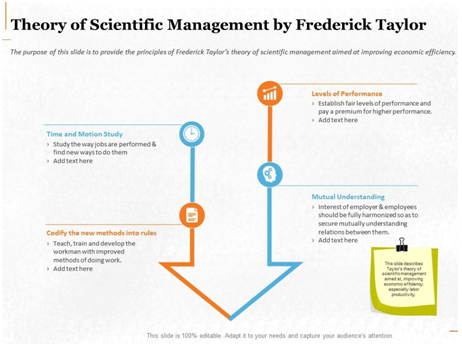
Figure 1: Theory of scientific management
(Source: Daddi et al., 2018)
Theory of scientific management- As noted by Dahlgaard-Park et al. (2018),this particular theory of management has been developed by Frederick Taylor. This theory aims at the betterment of financial efficiency focusing especially on labor productivity. According to Crosby, and Bryson (2018), this particular theory of management has been taking into account money as the chief motivating factor at the workplace. Moreover, this theory states that the workers are to be paid in accordance with the amount produced by them. As noted by Baltaci and Balc? (2017), a differential piece rate system ought to be implemented in the case of paying wages to the workers. As noted by Daddi et al. (2018), this particular theory of management is of the view that if the efficiency of the workers soars high than the prevailing standard then the workers ought to be paid 120% of the standard wage or normal piece rate. In case of less efficiency, the workers must be paid 80% of the normal piece rate. This particular theory of management assesses the way of performing the tasks & looks for newer ways of performing them efficiently. As noted by Ruben, and Gigliotti (2017), all the workers are trained & developed with the enhanced working technique by this particular theory of management aside from creating fair levels of performance & paying premiums to the workers for better performance. Moreover, as noted by Northouse (2021), the interest of the employees & the employers are carefully harmonized to develop their interrelations by this particular theory of management.
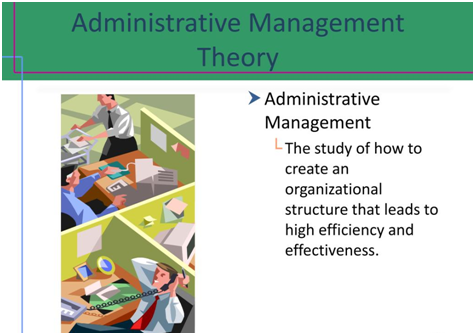
Figure 2: Administrative management theory
(Source: Dahlgaard-Park et al., 2018)
Administrative management theory- this particular theory of management had been developed by Henri Fayol. He had mapped out 14 principles of management. These principles can be banked on for the sake of managing the organizations effectively aside from mapping out the planning, predictions, process management, coordination, decision-making & control of the organizations. This theory states that the division of work ought to be implemented at the workplace to enhance accuracy, productivity & speed. As noted by Lee (2021), this particular theory of management states that the staff ought to be treated respectfully & equally. Moreover, discipline must be implemented for streamlining the job & making headway aside from encouraging the staff to take initiatives. Moreover, the establishment of mutual understanding & trust must be there apart from making the staff deliver their tasks with utmost responsibility. According to Bush, et al., (2019), this particular theory of management talks about providing job security to the staff aside from specifying the subordination of the individual interests by the same of the company. Remuneration of the employees is linked with the efforts made by themin the utmost manner. As noted by Daddi, et al., (2018), this particular theory of management talks about unifying the objectives of the employees at the workplace aside from making a balance between the division of power & hierarchy. The hierarchy ought to be implemented from top to bottom & there should never be more than a single boss at the workplace for avoiding confusion & conflicts. This particular theory of management defines that bringing in a positive ambiance at the workplace will summon positive outcomes as well.
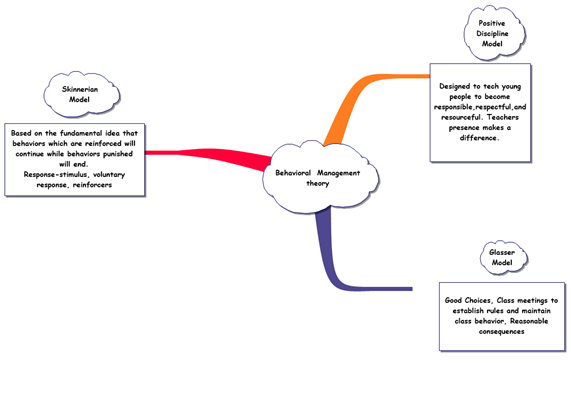
Figure 3: Behavioral theory of management
(Source: Dahlgaard-Park et al., 2018)
The behavioral theory of management- As noted by Northouse (2021), this particular theory had been developed by Elton Mayo. This particular theory of management has been taking into account psychological stimulus to enhance the productivity of the workers. As noted by Bratton (2020), it considers that psychological stimulus can be effectively banked on for increasing the productivity level of the entire workforce by making the employees be part & parcel of the workplace, important & very much involved within the operations. As noted by Dahlgaard-Park et al., (2018), this particular theory of management has been of the view that the novel changes like relocating of the workplace, cleaning work stations, etc. that are coming in the work environment bring in positive responses from the staffs as well. This particular theory of management states that as the employees feel being studied they tend to increase their productivity as well.
Leadership theories
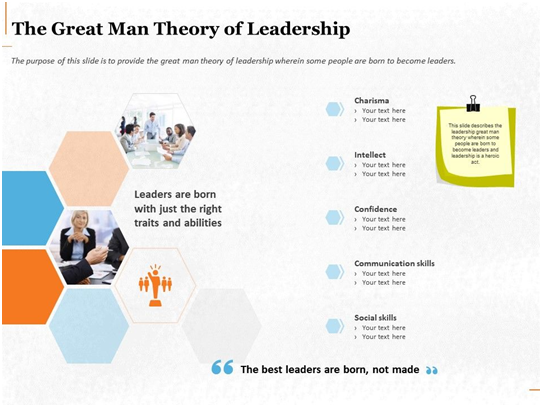
Figure 4: Great Man Theory
(Source: Antonakis and Day, 2018)
Great Man Theory- According to Fischeret al. (2017), this particular theory of leadership states that the leaders possess inborn appropriate traits as well as capabilities that are required for leading people. This theory states that leaders are born with the aptitudes like social skills, communication skills, aside from other qualities like confidence, charisma, intellect, etc. According to this particular theory of leadership, the ability to lead men & women is very much inherent in nature. As noted by Bratton (2020), this particular theory of leadership stands for the view that great leaders can never be made, they are born. Moreover, this theory defines the leaders as mythic, valiant & ordinate to lead people in the hour of need. This particular theory of leadership was mapped out on the basis of military leadership traits (Ellis, 2018).
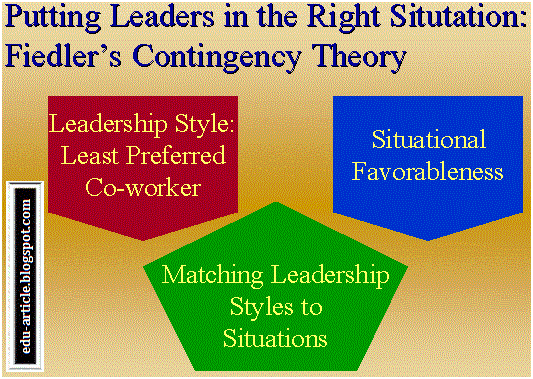
Figure 5: Contingency theory
(Source: Antonakis and Day, 2018)
Contingency theory- this particular theory of leadership stands for the belief that there are several different variables in the case of every specific setting which determine the best applicable leadership style for addressing that particular situation. This theory states that no single style of leadership can be applied in all situations. Moreover, according to Fischeret al.(2017), this particular theory of leadership tries to maintain a balance between the requirements, behaviors as well as contexts. The leaders who are capable & qualified enough possess the right qualities as well as the ability to assess the requirements of the situation & the followers. Moreover, according to Williset al. (2017), this theory stands for taking into account a lot of variables at the same point in time.
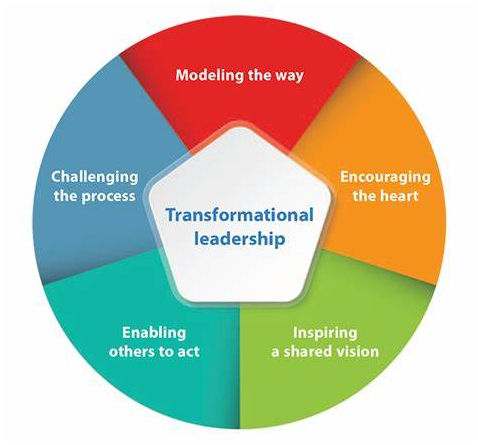
Figure 6: Transformational leadership theory
(Source: Antonakis and Day, 2018)
Transformational leadership theory- As noted by Bratton (2020), this particular theory of leadership keeps a close eye on monitoring the interrelationship between the followers & the leaders. According to this theory, the leaders ought to be charismatic apart from being inspirational enough to encourage the men & women who are following them in order to increase their productivity in an utmost manner (Ellis, 2018). Moreover, as noted by Baltaciand Balc? (2017), this particular theory of leadership talks about motivating the followers by showcasing the significance of their tasks & the benefits of performing those in an appropriate manner. According to Bush et al. (2019), these leaders aim at the performance of the team aside from boosting up the spirits of the team members in the utmost manner. Moreover, as noted by Ruben and Gigliotti (2017), transformational leaders always aim at brushing up on the skills that are possessed by their followers. Several crucial aspects are to be addressed by Laura as an associate director of a social enterprise. She will have to manage the workforce suitably while leading them to reach the targets of the organization in the utmost manner. As noted by Lee (2021), therefore, Laura will have to make a juxtaposition of the administrative theory of management with the contingency theory of leadership. This will help Laura to address the problems that she has been facing as an associate director of a social enterprise. The combination of these two theories of leadership & management will be quite beneficial for the organization she is leading. This will help make the approach of Laura quite dynamic in nature & address the situational changes in the most suitable manner. This will also enhance the leadership capacities as well as the decision-making capabilities of Laura as an associate director of a social enterprise. Moreover, through this, according to Fischeret al. (2017), Laura will be well able to facilitate the growth of the staff apart from allowing them to share their viewpoints which will generate the expansion of the organization itself. Furthermore, according to Willis, et al., (2017), it will help Laura to structure the working patterns of the organization in the most suitable method apart from taking informative decisions as well. Moreover, this will make Laura's approach quite comprehensive as an associate director of a social enterprise. This will also ensure the success of the organization in dealing with the issues that have been devastating its growth aside from managing all the required aspects effectively. Apart from this, according to Crosby and Bryson (2018), the combination of these two aforementioned theories of leadership & management will be immensely helpful for Laura as an associate director of a social enterprise by facilitating the organizational structure, promoting team concept within the organization, & invigorating the staffs via fair compensation. It will facilitate better engagement of the staff & will bring down the frustration level of the managers in the most effective manner (Antonakis and Day, 2018). The combination of these two theories will make the staff feel well motivated while plummeting down their workload effectively (Offermann and Coats, 2018). Laura as an associate director of a social enterprise will be well able to sort out the difficult problems aside from making informed decisions.
There are numerous steps that can be implemented by Laura as an associate director of a social enterprise for the sake of building the confidence of the staff working in that particular organization, she is leading. It will be quite necessary to establish the required momentum based upon the enduring accomplishments. As noted by Daddi et al. (2018), the accomplishments of the staff ought to be focused on by Laura as an associate director of a social enterprise. Moreover, she will have to give compliments to the staff for their performance on a very regular basis at the onset of the high turnover rate of the organization. It will be much needed to provide more tools & details when assigning the new tasks to the employees. In order to boost the confidence level of the staff, Laura will have to present the tasks to the staff in such a way that will showcase her confidence in the abilities of the staff (Offermann and Coats, 2018). Moreover, it can be quite helpful toassign mentors to the staff who are having lack confidence in performing their duties. As noted by Baltaci and Balc? (2017), Moreover, providing regular feedback to the staff regarding their performance will surely enhance the confidence level of these employees in the utmost manner. Aside from this, according to Williset al. (2017), as an associate director of a social enterprise, Laura can bank on the strategy of show appreciation towards the staff for doing a job most appropriately. As noted by Ruben, and Gigliotti (2017), this will stimulate the morale of the staff in the utmost manner. Appreciation will essentially help Laura to boost up the confidence of the employees as an associate director of a social enterprise. Furthermore, treating the staff with the utmost respect, being specific about the requirements, helping them adequately through proper training, making them aware of the needs & encouraging the staffs through their mistakes will help Laura to increase the confidence of the staffs as an associate director of a social enterprise.
Section 2
There are several skills & behavioral traits that ought to be taken into account by Laura as an associate director of a social enterprise alongside Kelly & Linda, the two managers of the organization. Three of these skills such as communication, motivation & trustworthiness alongside their significance & method of implementation are mapped out hereunder-
|
Leadership Skill/Behavior |
Significance |
Method of implementation |
Evaluation measures |
|
1) communication |
According to Crosby and Bryson (2018), for building oneself as a good leader it will be very much needful for the individuals to become very much adept in communicating with people. As noted by Adams (2018), better communication skills will be very much needful for the leaders of various kinds of organization to explain the requirements to the staffs in a suitable manner. Moreover, succinct as well as clear communication ought to be implemented for establishing n ambiance of cooperation & coordination throughout the organization they are leading (Offermann and Coats, 2018). According to Fischeret al. (2017), this communication skill will be helping out the leaders of various kinds of organizations to explain the organizational objectives as well as the assigned tasks to the staff in the most suitable way. Moreover, according to Tuczeket al. (2018), this will be immensely helpful for the leaders of various kinds of organizations to stay ahead of the game in cases like departmental, one-on-one as well as full-staff conversations. As noted by Ruben, and Gigliotti (2017), proper communication skills will surely enhance the capacity of the organizational leaders to communicate with the stakeholders as well as with the employees via chat, phone, social media & email. Moreover, according to Bush et al. (2019), it will help the leaders to get into a steady flow of communication amid them & with the employees via open-door policies or conversing with the employees ever & anon. Careful listening to the staff by the leaders of various kinds of organizations will enhance the interrelationship of the leaders with the other staff members of the organizations. Moreover, according to Williset al. (2017), proper communication with the leaders will surely help in sorting out the issues as well as concerns of the staff adequately.
|
According to Willis, et al. (2017), for the sake of building up their communication skill the leaders of various kinds of organizations will have to closely listen to the employees as well as analyze their perspectives. As noted by Northouse (2021), the leaders ought to make them well available to the staff of the organization to discuss the concern & the issues that are coming up in the workplace. Articulating as well as active listening will be the key for the leaders of various kinds of the organization (Van Wart et al. 2017). Moreover, according to Bush et al. (2019), they will have to implement clarity, correspondence, concision, expression, etc. to get to the bottom of the employee mindset. Moreover, according to Tuczeket al. (2018), the leaders will have to implement the techniques like business storytelling, nonverbal & verbal communications, public speaking, written communication, reading body language, presentation & reducing ambiguity, etc. in order to develop their communication skill.
|
According to Crosby and Bryson (2018), assessing the ways of workplace interaction, the role played by the leaders in assigning the tasks to the employees will be much needed. Moreover, the existing level of cooperation& collaboration within the workplace can be evaluated too (Van Wart et al. 2017). |
|
2) Motivation |
The leaders of various kinds of organizations will have to develop themselves to invigorate the workers to bring out their best potentiality. It is not sufficient for the leaders to allocate the salary of the staff & think that they will be taking care of the rest. Motivation skills will be much needed for the leaders of various kinds of organizations to establish the self-esteem of the staff & make them aware of the organizational goals. As noted by Daddi et al. (2018), recognition, as well as rewards, can also be allotted for the staff in order to enhance their morale & desire to work harder for the organization. Moreover, according to Ruben and Gigliotti (2017), giving new responsibilities to the employees will also increase their confidence. Moreover, as viewed by Tuczeket al. (2018), through this motivation skilled leaders can bring out the best capacity of the leaders & utilize the human resources to the fullest for the company. Furthermore, they will be very much able to facilitate the development of the individual employees which ultimately will generate better productivity & profitability for the organization. As viewed by Guhr et al. (2019), this will make the leaders of various kinds of organizations get to the bottom of the minds of the employees & it will also increase the productivity of the entire team by leaps & bounds. Furthermore, it will also facilitate passion among the employees.
|
In order to develop their skill to motivate people, the leaders of various kinds of organizations will have to learn the different motivating factors of different employees. Moreover, as noted by Daddi et al. (2018), they will have to allow the autonomy of the employees while asking them to give their inputs. Evaluating the interests of the staff will be very much needed aside from convincing & mentoring them adequately. The leaders of various kinds of organizations will have to keep themselves open to the concerns of the employees apart from providing rewards to the staff based on their performance (Van Wart et al. 2017). As viewed by Guhr et al. (2019), setting effective objectives, recognizing & thanking the efforts put in by the staff will be quite needed. Aside from this, understanding the differences of the employees & implementing team-building aptitudes will be the key here.
|
Assessing the employee behavior in dealing with difficult situations will be the key. As noted by Adams (2018), the level of interaction amidst the leaders & the employees & the perception of the staff about their leaders can be estimated as well. |
|
3) trustworthiness |
The leaders of various kinds of organizations will have to develop this particular leadership quality in order to attain acceptability to the employees while facilitating transparency of the organizational operations as well (Antonakis and Day, 2018). The trustworthiness of the leaders of various kinds of organizations will make the staffs of the organizations feeling comfortable to come to the leaders & managers for the sake of discussing the necessary staffs. As noted by Adams (2018), this will also facilitate a suitable ambiance in which the staff of the organizations will be feeling at large to share their concerns & questions with the managers &organizational leaders. As noted by Northouse (2021), this will be showcasing the integrity of the organization in the utmost manner. This particular leadership quality will make the leaders of various kinds of organizations gain respect from the employees in the utmost manner. According to Tuczeket al. (2018), this will also facilitate openness as well as honesty within the workplace. Furthermore, as noted by Daddi et al. (2018), the honesty demonstrated by the organization’s leaders will generate some kind of honesty amid the employees too.
|
In order to attain trustworthiness, the leaders will have to be honest & open. The leaders of various kinds of organizations will have to showcase the capability to beg apology when it is required & remain accountable to the staff for whatever role they are playing within the workplace (Offermann and Coats, 2018). Maintaining business ethics, abiding by the rules of confidentiality, conscientiousness, credibility & empathy will be much needed. Moreover, the leaders of various kinds of organizations will have to remain consistent in their behavior towards the staff. It will be much needed for the leaders of various kinds of organizations to showcase emotional intelligence, integrity, moral compass, respectfulness, thoughtfulness, honesty, & reliability to turn up as a trustworthy leader (Antonakis and Day, 2018). |
As viewed by Guhr et al. (2019), analyzing the opinions of the employees about their leaders will be the key. Employee feedbacks, workplace clarity & the reliability of the leaders ought to be assessed. |
In order to attain trustworthiness, the leaders will have to be honest & open. The leaders of various kinds of organizations will have to showcase the capability to beg apology when it is required & remain accountable to the staff for whatever role they are playing within the workplace (Offermann and Coats, 2018). Maintaining business ethics, abiding by the rules of confidentiality, conscientiousness, credibility & empathy will be much needed. Moreover, the leaders of various kinds of organizations will have to remain consistent in their behavior towards the staff. It will be much needed for the leaders of various kinds of organizations to showcase emotional intelligence, integrity, moral compass, respectfulness, thoughtfulness, honesty, & reliability to turn up as a trustworthy leader (Antonakis and Day, 2018). As viewed by Guhr et al. (2019), analyzing the opinions of the employees about their leaders will be the key. Employee feedbacks, workplace clarity & the reliability of the leaders ought to be assessed.
Conclusion
The aforementioned leadership & management style can be banked on by Laura as an associate director of a social enterprise to sort out the issues that she has been facing in the case of managing the organization effectively while leading the staff with utmost efficiency. Moreover, it is noteworthy that the duty of a leader of any organization is not a palm job at all. Therefore, Laura will have to go very closely as an associate director of a social enterprise. Moreover, it will be much needed for the organization to make the employees engaged with the organizational activities while abrading the frustration of the managers. Laura will have to count on the aforementioned leadership skills & behaviors as an associate director of a social enterprise along with Kelly & Linda, the two managers of the organization. As noted, the proper implementation of these leadership skills & behaviors will help any organization to mitigate workplace issues of any kind.
References
Adams, D., 2018. Mastering theories of educational leadership and management. University of Malaya Press.
Antonakis, J. and Day, D.V., 2018. Leadership: Past, present, and future.
Baltaci, A. and Balc?, A., 2017. Complexity leadership: A theorical perspective. International Journal of Educational Leadership and Management, 5(1), pp.30-58.
Bratton, J. ed., 2020. Organizational leadership. Sage. Bush, T., Bell, L. and Middlewood, D. eds., 2019. Principles of educational leadership & management. Sage.
Crosby, B.C. and Bryson, J.M., 2018. Why leadership of public leadership research matters: and what to do about it. Public Management Review, 20(9), pp.1265-1286.
Daddi, T., Todaro, N.M., De Giacomo, M.R. and Frey, M., 2018. A systematic review of the use of organization and management theories in climate change studies. Business Strategy and the Environment, 27(4), pp.456-474.
Dahlgaard-Park, S.M., Reyes, L. and Chen, C.K., 2018. The evolution and convergence of total quality management and management theories. Total Quality Management & Business Excellence, 29(9-10), pp.1108-1128.
Ellis, P., 2018. Leadership, management and team working in nursing. Learning Matters.
Fischer, T., Dietz, J. and Antonakis, J., 2017. Leadership process models: A review and synthesis. Journal of Management, 43(6), pp.1726-1753.
Guhr, N., Lebek, B. and Breitner, M.H., 2019. The impact of leadership on employees' intended information security behaviour: An examination of the full?range leadership theory. Information Systems Journal, 29(2), pp.340-362.
Lee, M.R., 2021. Leading virtual project teams: Adapting leadership theories and communications techniques to 21st century organizations. CRC Press. Northouse, P.G., 2021. Leadership: Theory and practice. Sage Publications. Offermann, L.R. and Coats, M.R., 2018. Implicit theories of leadership: Stability and change over two decades. The Leadership Quarterly, 29(4), pp.513-522.
Ruben, B.D. and Gigliotti, R.A., 2017. Communication: Sine qua non of organizational leadership theory and practice. International Journal of Business Communication, 54(1), pp.12-30.
Tuczek, F., Castka, P. and Wakolbinger, T., 2018. A review of management theories in the context of quality, environmental and social responsibility voluntary standards. Journal of cleaner production, 176, pp.399-416.
Van Wart, M., Roman, A., Wang, X. and Liu, C., 2017. Integrating ICT adoption issues into (e-) leadership theory. Telematics and Informatics, 34(5), pp.527-537.
Willis, S., Clarke, S. and O'Connor, E., 2017. Contextualizing leadership: Transformational leadership and Management?By?Exception?Active in safety?critical contexts. Journal of Occupational and Organizational Psychology, 90(3), pp.281-305.












